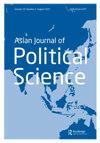NOTA: a strategic choice with a positive impact on Indian elections
IF 1
Q3 POLITICAL SCIENCE
引用次数: 0
Abstract
ABSTRACTIn this article, we study how the introduction of a None of the Above (NOTA) option in Indian elections since 2013 has affected voting patterns and election outcomes. First, we examine the relationship between position on the ballot with electoral outcomes by constructing a simple statistic that measures relative performance by position on the ballot or Electronic Voting Machines. Within non-party options, we show that the last option on the EVM ends up being a salient choice, which is an inversion of the usual findings in the literature on order effects, where earlier options are generally preferred. Second, the NOTA option is the salient choice for voters who choose not to vote for a party, and thereby substituting for independent candidates. This share is more than can be explained by ballot position alone. We argue that the existence of a NOTA option is not merely a procedural technicality; instead, voters use NOTA as a strategic option to express their protest.KEYWORDS: None of the AboveIndian ElectionsOrder of CandidatesStrategic ChoiceDemocracyIndependents AcknowledgementWe would like to acknowledge insightful discussions with T.S. Krishnamurthy, Jagdeep Chokhar. V. Suresh, Brinda Viswananthan and Manjushree Hegde.Disclosure statementNo potential conflict of interest was reported by the author(s).Notes1 For details, see People’s Union for Civil Liberties v Union of India (Citation2013): Writ Petition (Civil) No 161 of 2004, Supreme Court judgment dated 27 September 2013.2 Specifically, rules 41(2), 41(3) and 49-O. 41(2) and (3) of the Conduct of Election Rules, 1961 directed the voter who took the ballot and decided not to use it to return it to the presiding officer. These ballots were then kept in a separate packet. Rule 49-O catered to the voter who, in the polling booth, chose not to cast vote and put it on record.3 For more details on the rules see https://indiankanoon.org/doc/152734757/ and https://eci.gov.in/faqs/evm/general-qa/electronic-voting-machine-r2/, accessed on 17 July 2022.4 Past analyses of elections have included metrics like the Herfindahl index, defined as the sum of the squares of percentage shares (this is minimized for a uniform distribution); and the Kullback-Leibler distance, which is an entropy-based measure of how different a distribution is from the uniform. Our statistic is much easier to calculate, and has the following properties—A candidate with a lower percentage share than the overall average will have a negative DPS value, and a candidate with a higher percentage share than the overall average will have a positive DPS value. The minimum value of the statistic, −1/N, is reached when the candidate in question gets 0 votes and the maximum value, 1−1/N, when he gets all the votes. Further, DPSi values always sum up to zero over all candidates for a given election5 Subramanian Swamy vs A. Raja on 24 August 2012; In 2017, all the accused in the 2G scam were acquitted by the Special CBI Court Judge O. P. Saini since the prosecution could not prove the case.Additional informationNotes on contributorsRaghav KumarRaghav Kumar works in data science after completing his masters degree from Madras School of Economics, Chennai, India. His thesis focussed on changes in voting patterns after introduction of NOTA in India.Sudarsan PadmanabhanSudarsan Padmanabhan is an Associate Professor in the Department of Humanities and Social Sciences, Indian Institute of Technology Madras, Chennai, India. Sudarsan specializes in social and political philosophy, Indian philosophy and culture. Sudarsan's research focus is on the confluence of law, politics, and ethics in the public sphere.P. SrikantP. Srikant is a Visiting Faculty at Madras School of Economics, Chennai, India. Srikant specialises in finance.注:这是对印度选举产生积极影响的战略选择
在本文中,我们研究了自2013年以来在印度选举中引入“以上皆非”(NOTA)选项对投票模式和选举结果的影响。首先,我们通过构建一个简单的统计数据来衡量选票上的位置或电子投票机的相对表现,从而检查选票上的位置与选举结果之间的关系。在非政党选项中,我们表明EVM上的最后一个选项最终是一个突出的选择,这是关于顺序效应的文献中通常发现的反转,其中较早的选项通常更受欢迎。其次,NOTA选项是选择不投票给某一政党的选民的突出选择,从而取代了独立候选人。这一比例超出了单凭投票情况所能解释的范围。我们认为,NOTA选项的存在不仅仅是程序上的技术性问题;相反,选民使用NOTA作为表达抗议的战略选择。关键词:以上都不是印度选举候选人顺序战略选择民主独立承认我们要感谢与T.S.克里希那穆尔蒂,贾格迪普乔克哈尔的深刻讨论。V. Suresh, Brinda Viswananthan和manjusthree Hegde。披露声明作者未报告潜在的利益冲突。注1有关详细信息,请参见公民自由人民联盟诉印度联盟(Citation2013):最高法院2013年9月27日判决的2004年第161号书面请愿书(民事)。具体而言,规则41(2),41(3)和49-O。1961年《选举规则》第41(2)和(3)条指示拿了选票但决定不使用的选民将选票交还给主持选举的官员。然后这些选票被保存在一个单独的包里。规则49- 0迎合了那些在投票站选择不投票并将其记录在案的选民有关规则的更多细节,请参阅https://indiankanoon.org/doc/152734757/和https://eci.gov.in/faqs/evm/general-qa/electronic-voting-machine-r2/,访问日期为20222年7月17日。过去对选举的分析包括像赫芬达尔指数这样的指标,定义为百分比份额的平方和(这是均匀分布的最小值);以及Kullback-Leibler距离,这是一种基于熵的测量分布与均匀分布的差异程度的方法。我们的统计数据更容易计算,并且具有以下属性—具有低于总体平均值的百分比的候选值将具有负DPS值,并且具有高于总体平均值的百分比的候选值将具有正DPS值。当候选人获得0票时,统计值达到最小值- 1/N,当他获得所有选票时,统计值达到最大值1 - 1/N。此外,在特定选举中,所有候选人的DPSi值总和总是为零(2012年8月24日Subramanian Swamy vs a . Raja);2017年,特别CBI法庭法官o.p. Saini宣布2G诈骗案中的所有被告无罪释放,因为控方无法证明这一案件。raghav Kumar在印度金奈马德拉斯经济学院获得硕士学位后,从事数据科学工作。他的论文集中在印度引入NOTA后投票模式的变化。Sudarsan Padmanabhan是印度金奈马德拉斯印度理工学院人文与社会科学系副教授。Sudarsan专门研究社会和政治哲学,印度哲学和文化。苏达桑的研究重点是法律、政治和伦理在公共领域的融合。SrikantP。Srikant是印度金奈马德拉斯经济学院的客座教授。Srikant专门研究金融。
本文章由计算机程序翻译,如有差异,请以英文原文为准。
求助全文
约1分钟内获得全文
求助全文
来源期刊

Asian Journal of Political Science
POLITICAL SCIENCE-
CiteScore
2.00
自引率
0.00%
发文量
11
期刊介绍:
Asian Journal of Political Science ( AJPS) is an international refereed journal affiliated to the Graduate School of Public Administration, Seoul National University. Published since 1993, AJPS is a leading journal on Asian politics and governance. It publishes high-quality original articles in major areas of political science, including comparative politics, political thought, international relations, public policy, and public administration, with specific reference to Asian regions and countries. AJPS aims to address some of the most contemporary political and administrative issues in Asia (especially in East, South, and Southeast Asia) at the local, national, and global levels. The journal can be of great value to academic experts, researchers, and students in the above areas of political science as well as to practical policy makers, state institutions, and international agencies.
 求助内容:
求助内容: 应助结果提醒方式:
应助结果提醒方式:


